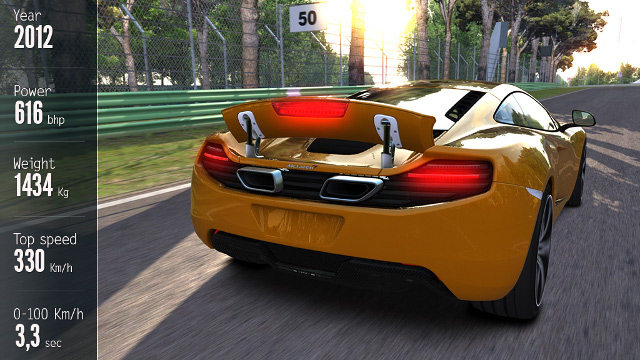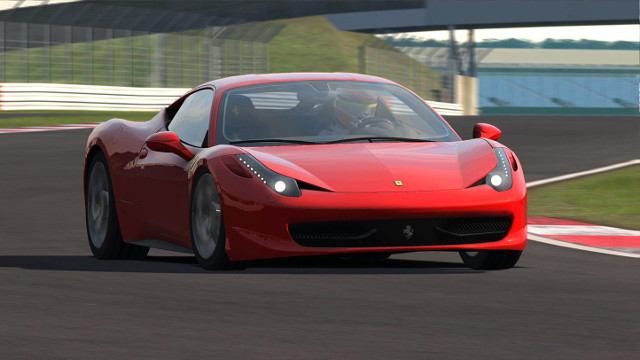While at E3 this past week I had a chance to meet with three members of Kunos Simulazioni, the Italy-based development team behind what I've consistently heard regarded as the most accurate racing simulator on the market. That game is Assetto Corsa, and as a car and racing simulator fan who had previously never experienced the title, I was excited to see why the game has earned its reputation.
I began my adventure by speaking with Co-Founder and Lead Developer Stefano Casillo. Talking with him for several minutes I got an idea of just how passionate the team is about simulating cars and the racing experience. He shared that many professional drivers use Assetto Corsa for training and preparation purposes, which has made the team's meticulous attention to detail fulfilling, while also bringing on an increased sense of responsibility for portraying each vehicle as accurately as possible.
One of the development team's most interesting stories was its implementation of the highly sophisticated Pagani Huayra. After modeling the car and equipping it with all the data points needed to be integrated into the game similar to the rest of Assetto Corsa's car cast, the team was shocked to find that it handled nothing like it does in real-life. As it turns out, the Huayra is the only car in the world equipped with four independently operating flaps, two in the front and two in the back. These flaps are managed by a control unit to provide maximum downforce and minimal drag under all circumstances, whether the car is hitting a sharp turn at 40 miles per hour, or sweeping through a chicane.

The problem was that the team hadn't implemented the physics for these flaps due to them being one-of-a-kind. In order to ensure that the vehicle was a true simulation, Kunos Simulazioni would have to design a unique physics system for these flaps, fully reconstructing its complex flap patterns in video game context. It was a daunting task that no other developer has tackled, and would take weeks to complete. At the end, both the Huayra's vitals and its four flaps were integrated into the game, reproducing the car's tremendous speed and finesse with an attention to detail unique to Assetto Corsa.
I took the moment to ask Stefano Casillo as to whether or not manufacturers ever feel unhappy with how their cars perform in relation to other vehicles in the game. He responded by telling me that in every circumstance manufacturers greatly appreciate how the team represents their automobiles with precision, and are usually surprised by how much data Kunos Simulazioni requests before beginning design and implementation.
This meticulous design philosophy has given many car enthusiasts who may never be able to drive exotic cars a chance to experience what they're really like. Take for example the McLaren MP4-12C, a vehicle that was one of the most sought after from 2011 to 2014. What many, including myself, wouldn't know is that McLaren designed this car to be true to its racing heritage, which means that it is a very difficult car to pilot for inexperienced drivers. Unlike cars equipped with powerful assists such as the Ferrari 458, it doesn't go out of its way to correct the mistakes of drivers, instead placing the responsibility of the vehicle in the hands on the driver. What this meant for Assetto Corsa was the addition of a car that many found difficult to handle, a far cry from the very tame nature of its iteration in other racing games that don't prioritize simulation.

This simulative nature is rare in today's racing game market. Many racers claim to be true racing simulators, but their developers don't make the effort to define the unique properties of each car. The developers of the most popular racing games end up seeking quantity over quality because it's easier to sell to consumers. After all, only those with a strong car palate can tell the difference. For those who enjoy sitting behind a racing wheel and experiencing these cars for what they truly are, Assetto Corsa's exactitude matters.
I ended my meeting by getting hands-on with the game. I was able to sit in a dedicated racing setup equipped with one of the best racing wheels on the market, the Thrustmaster T500RS. I would end up driving around Autodromo Nazionale Monza for six laps in a Ferrari 458 while being guided by one of Kunos Simulazioni's team members. Before beginning I asked him about his experience and learned that he's driven countless laps around Nurburgring Nordschleife, which is both my favorite track in the world as well as his. As with many members of the Kunos Simulazioni team, making a racing simulator isn't just a job of his, it's a hobby that stems from his affection for cars.
He would provide me with a wealth of tips and information as I raced around Monza trying to cut down my lap times, pointing out the optimal brake points and teaching me how to best utilize the capabilities of the Ferrari 458. As someone who has driven the car for countless hours in a variety of video games including laps around Monza, I was shocked at how much there was to learn due to Assetto Corsa's complexity. I've admittedly never driven a real Ferrari 458 around Monza, but what I experienced was the closest to true simulation that I've ever experienced.

I was floored by how mechanically sophisticated the physics of Assetto Corsa are. I could feel every imperfection in Monza's road via feedback as well as the difference tire temperature makes as I pushed the Ferrari 458 to its limits. Stefano Casillo explained to me earlier that tarmac is simulated in a very big way, taking into account the heat of tires, the number of vehicles on the track, as well as the rubber that naturally finds its way into the pavement. This, in combination with the game's laser-scanned tracks, provides a realistic environment for the finely-crafted cars.
What is perhaps most impressive about Assetto Corsa is its development team. Kunos Simulazioni is composed of a group of around 18 talented people who absolutely love cars (their headquarters is at the ACI Vallelunga Circuit). As someone who plays racing games all the time, I would have never been able to tell that such a small group of programmers, artists, and designers were able to craft a game of this caliber.
Before I left I spoke to Aristotelis Vasilakos who works on the game's physics and user interface. He shared with me that the PlayStation 4 and Xbox One versions of the game are in a healthy state of development slated for a release in 2016. He emphasized that these versions will not be watered down versions of the game; they will be the same top-tier racing simulator that has become a staple of racing simulation fans for more than a year. These versions will include the entirely free bonus packs that the PC version has earned a reputation for. Some cars of note on the horizon include the legendary Lamborghini Miura as well as a special Ferrari that will be announced at a later date. Soon, even those without a capable gaming PC will be able to see what all the fuss is about.











